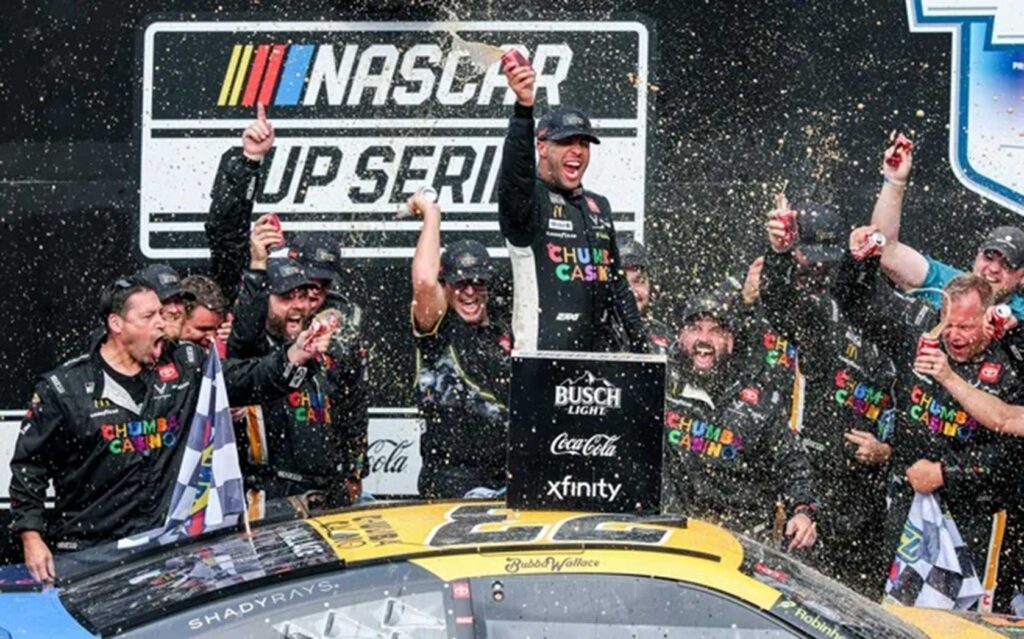
Banner Sports Sponsored by the Patriots Foundation
Two significant historical events occurred on the auspicious day of July 27, 2025. Five players entered the hallowed halls of the Baseball Hall of Fame, and a Black man became the first African American driver to win the Indy 400 auto race at the Indianapolis Motor Speedway.
New inductees Dave Parker, Dick Allen, Billy Wagner, Carsten Charles (CC) Sabathia, and Ichiro Suzuki are now enshrined in Cooperstown, N.Y., alongside the greatest players in baseball history. And while their ceremony was taking place, Black NASCAR driver William Darrell “Bubba” Wallace carved his name into auto racing history by winning the Brickyard 400 race. These six men now share a place in sports history forever. All readers of this article should consider the parallel significance of what these two athletic events represent.
The name of Jackie Robinson is deeply woven into the fabric of American sports history as the Black man who broke baseball’s infamous color line in 1947. Following a brilliant 11-year playing career, Robinson became the first Black player to be inducted into the Baseball Hall of Fame in 1962, in his first year of eligibility. His contributions both on and off the field elevated all sports to where they are today. Every athlete, especially of color, in the field of modern-day sports owes a tremendous debt to Jackie Robinson.
Bubba Wallace joined that list when he crossed the famed brick-covered finish line and took the checkered flag of victory at Indy. He can also look at the racing Hall of Famer Wendell Scott, who was the first Black NASCAR driver to win an event on Dec. 1, 1963, at Speedway Park, a small track near Jacksonville, Fla. This win for Wallace is also significant because 23X1 racing is co-owned by former NBA star Michael Jordan. “He was just so proud,” Wallace said of Jordan. “I said, ‘I wish you were here for it.’ He was like, he’s going to have a drink or two for me tonight. So, we’ll be celebrating together in spirit.”
I am confident that somewhere in the dimension of this lifetime, Jackie Robinson and Wendell Scott are beaming with pride over Wallace’s landmark sports achievement.
But on this day, Jackie Robinson’s legacy and vision are centered on the happenings at Cooperstown because baseball — America’s grand old game — is where he made his name and gained his fame.
Robinson would be proud to shake the hands of William Edward “Billy” Wagner, who described himself as “five-foot-nothing, a 100-pound nothing” and made it to the Hall of Fame as a left-handed relief pitcher who amassed 422 saves — the eighth most of all time — and held hitters to a .187 batting average, striking out 33% of the batters he faced over his 16 year career.
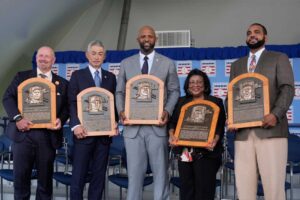
The Baseball Hall of Fame Class of 2025: (from left) Bily Wagner, Ichiro Suzuki, CC Sabathia, Willa Allen, widow of Dick Allen, and Dave Parker II, son of Dave Parker. PHOTO: SETH WENIG
Wagner’s accomplishment is more stunning when you realize that he is right-handed. He broke his right arm twice as a child and learned to pitch left-handed at age 10. He also overcame a devastating injury to his face when a batted ball struck him. He came back and closed out his career, still throwing 100-mile-per-hour fastballs.
Dave “the Cobra” Parker and Richard “Dick” Allen now exist in eternity as the two inductees who posthumously entered the Hall of Fame. Both men were elected by the Classic Baseball Era Committee far too late for them to speak.
Parker’s son, Dave Parker II, and Allen’s widow, Willa, spoke for the two men, but, unfortunately, it took so long for the duo to receive their just due.
Parker was a two-time World Series champion and a two-time batting champion, with over 2,700 career hits and a .290 career batting average. The former Oakland A’s and Pittsburgh Pirates outfielder was the 1978 National League Most Valuable Player. The seven-time All-Star and multiple Gold Glove winner died just weeks before his induction into the Hall of Fame.
The irony of Parker’s legacy is that he became the Pittsburgh Pirates’ right fielder seven months after the death of Hall of Famer Roberto Clemente, who manned the position for 18 spectacular years. A greater coincidence is that both Parker and Clemente, two of baseball’s greatest five-tool players, are enshrined in the Hall of Fame posthumously.
Dick Allen’s story is one of perseverance and determination in the pursuit of success. Starting his 15-year playing career with the Philadelphia Phillies in 1964, the man from Wampum, Pa., compiled a .292 lifetime batting average, 351 home runs, and 1,129 runs batted in while swinging a 35-inch, 42-ounce bat — one of the heaviest in baseball history.
Allen was named the American League Most Valuable Player in 1972 while playing for the Chicago White Sox; however, his legacy shone brightest during his days as a Phillie, when he suffered major abuse from the media and fans.
“Dick and I both endured the wrath of Phillies fans during our playing days in that city,” said Hall of Fame Phillie third baseman Mike Schmidt “The abuse that Dick suffered was greater than mine. We became kindred spirits who now share a place in the Hall and the affection of Phillies fans.”
CC Sabathia and Ichiro Suzuki traveled different paths to Cooperstown. Sabathia overcame substance addiction to win 251 games and became one of only 20 pitchers overall with 3,000-plus strikeouts (3,089), and one of only three left-handed pitchers in baseball history, along with Hall of Famers Randy Johnson and Steve Carlton, to accomplish the feat during his 19-year career. One of the biggest highlights of his career came in 2009, when he won a World Series title with the Yankees.
Sabathia was a six-time All-Star and won a Cy Young Award in 2007, the first pitcher to begin his career in the 21st century and be inducted into the Hall of Fame in his first year on the ballot. And he is the third member of Black Aces, a group of 15 African American pitchers who have had at least one 20-win season, to enter the Hall.
Ichiro Suzuki brought down the house by delivering his acceptance speech in English. For years, I have told people that he speaks English. I guess they are believers now. Thank you for the class and dignity you displayed throughout your entire, scintillating 27-year playing career in both Japan and the United States.
Suzuki is the first Japanese player to reach the Hall. Just think of this mind-blowing statistic: 4,367 career professional hits, including time in Japan’s Nippon Professional Baseball. Suzuki did not make his Major League Baseball debut until he was 27 and ranks 24th all-time with 3,089 hits in Major League Baseball. He had 200-plus hits in each of his first 10 seasons. The outfielder led the league in hits for five consecutive seasons, and led the league seven times overall, tying him with Ty Cobb and Pete Rose for the most in MLB history.
Suzuki was the all-time single-season hits leader with 262 in 2004, breaking the record set by Hall of Famer George Sisler in 1920, and a 10-time Gold Glove winner. After a Hall of Fame career in Japan — he will be officially inducted in his home country on August 31 — Ichiro came to America and left no doubt as to his greatness by winning both the Rookie of the Year and Most Valuable Player awards in his first season with the Seattle Mariners.
Congratulations to the 2025 Class of the Baseball Hall of Fame and a salute to Bubba Wallace for making July 27, 2025, a day to be remembered.





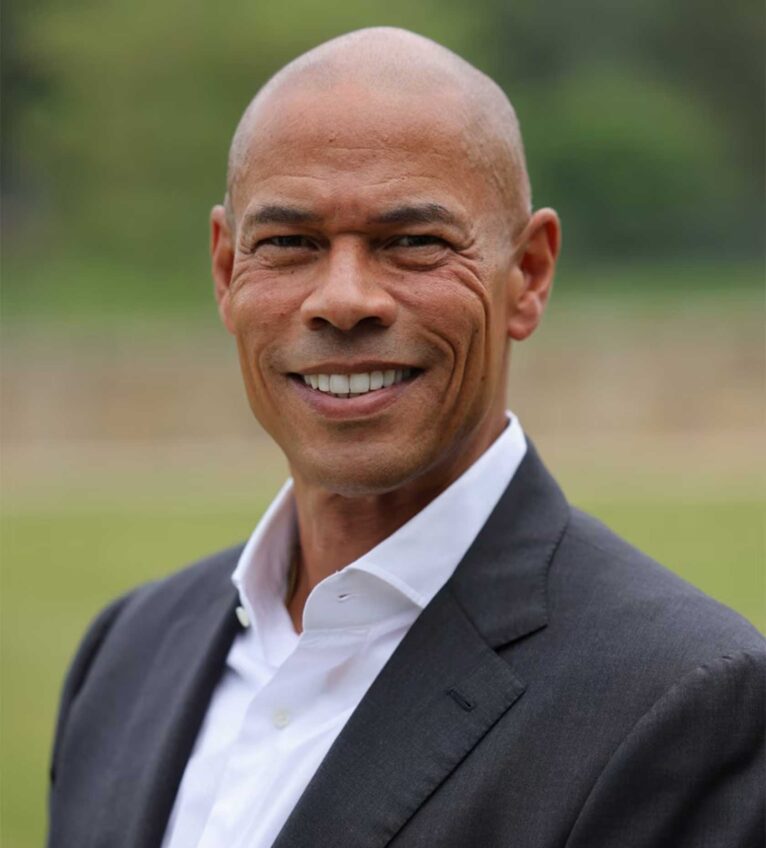
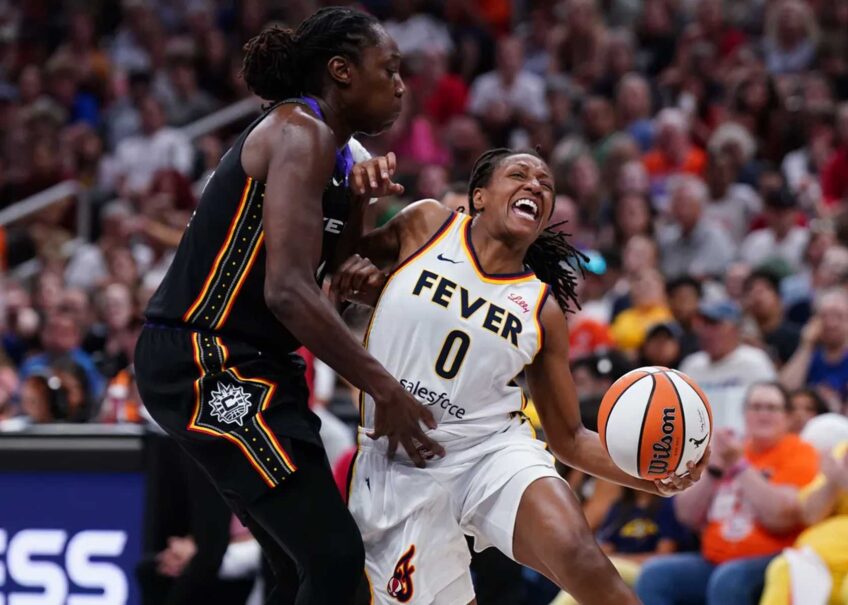
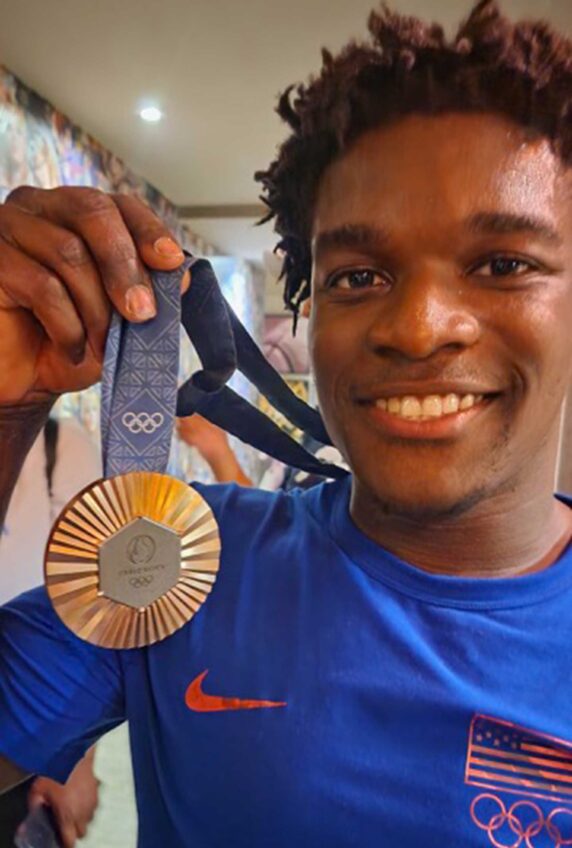
Leave a Reply
You must be logged in to post a comment.